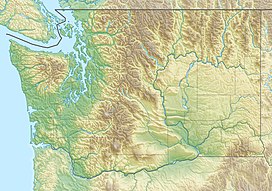| Mount Lena | |
|---|---|
 Mt. Lena, southeast aspect | |
| Highest point | |
| Elevation | 5,995 ft (1,827 m) [1] [2] |
| Prominence | 1,035 ft (315 m) [1] |
| Parent peak | Mount Stone (6,612 ft) [3] |
| Isolation | 3.33 mi (5.36 km) [3] |
| Coordinates | 47°38′24″N123°12′55″W / 47.6399421°N 123.2151525°W [4] |
| Geography | |
| Country | United States |
| State | Washington |
| County | Jefferson |
| Protected area | Olympic National Park |
| Parent range | Olympic Mountains |
| Topo map | USGS The Brothers |
| Climbing | |
| First ascent | Unknown [2] |
| Easiest route | class 2 hiking [3] |
Mount Lena is a 5,995-foot-elevation (1,827-meter) mountain summit located in the Olympic Mountains, in Jefferson County of Washington state. [4] It is situated within Olympic National Park, immediately north and 1,500 feet above the shore of Upper Lena Lake. Mt. Lena has a subsidiary peak, East Peak (5800+ ft/1768+ m), which lies northeast of the lake. [5] Mount Bretherton lies across the lake to the south, Mount Stone is three miles to the southwest, and The Brothers approximately 3.5 miles to the northeast. Precipitation runoff from the mountain drains north to the Duckabush River, and south into the Hamma Hamma River via Lena Creek. The non-technical ascent of Mount Lena involves hiking eight miles (one-way) and 5,300 feet elevation gain via the Upper Lena Lake Trail and cross-country above the lake, with most favorable conditions from July through September. [6] There are pleasant campsites at the lake, and the ascent to the summit takes 1.5 hour from the lake. [7] This mountain's toponym has been officially adopted by the United States Board on Geographic Names. [4]


